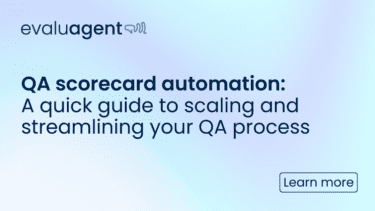QA scorecard automation: A guide to scaling and streamlining your QA process


Contact centre quality assurance (QA) scorecards have undergone a remarkable transformation in recent years. The traditional scorecard, once a rigid checklist of agent behaviours, has the potential to evolve into a far more dynamic tool – one that leverages AI and automation to drive efficiency, accuracy, and fairness to contribute to the goal of exceptional customer service.
But what does this shift look like in practice?
In this article, we’ll break down typical QA scorecard line items into four key categories:
By re-evaluating the role of each scorecard item, and handing off to AI and automation with peace of mind, you can streamline processes, improve accuracy, and focus on what truly matters: delivering excellent customer experiences.
Conversation intelligence tools have transformed how we analyse customer interactions. Advanced speech and text analytics can now detect patterns, conversational dynamics and behaviours within customer conversations in real time, removing the need for human evaluators to manually score certain agent behaviours.
Example line item: “Agent gives customer opportunity to speak”
Replacement: Now handled by conversation intelligence Overtalk metric.
In the past, QA teams would have to manually assess whether agents allowed customers to speak without interruption. Now, AI-driven conversation intelligence tools can automatically track interruptions, speaking ratios, and overtalk to assess service quality. This not only speeds up quality assurance evaluations, but also removes subjectivity from the process.
Another way you could use conversation intelligence to automate would be using the Silence percentage metrics, which negates the need for line items like ‘Does the agent put the customer on hold appropriately?’.
The possibilities are almost endless. Learn more about evaluagentCX’s conversation intelligence and how it can deliver great outcomes.
Text analytics allows quality assurance (QA) teams to process large volumes of structured and unstructured data at scale. It’s particularly useful for rule-based assessments where clear, predefined criteria exist.
Example line item: “Agent obtains 3 pieces of customer information for ID&V”
Replacement: Automated with text analytics.
Rather than manually checking whether an agent has confirmed three ID&V (Identification & Verification) elements, text analytics can scan the transcript for key verification terms, improving compliance across 100% of conversations, while also reducing evaluation time.
Another example could be ‘Agent advises the customer that calls are recorded for training and monitoring’. We’re also seeing financial services firms using text analytics to identify different types of customer vulnerability – and then ascertain whether agents have used appropriate frameworks (e.g. TEXAS).
Text analytics are a huge time-saving measure, automatically detecting critical aspects within the conversation.
As you’re no doubt aware, generative AI and natural language processing (NLP) are advancing rapidly. The good news is this enables far more nuanced assessments of agent performance since AI-driven QA can now evaluate complex interactions, even when they require contextual understanding.
Example line item: “Agent uses appropriate questioning to support the customer”
Replacement: Assessed using a generative AI QA prompt.
You could also apply this to line items such as ‘Agent handles customer objections, positively explaining the benefits’ and ‘Agent sounds confident and knowledgeable’.
This is an area where AI gets to really shine. Generative AI models can assess whether an agent’s questioning aligns with best practices, providing instant feedback on whether they asked clarifying, open-ended, or probing questions. This moves QA beyond binary scoring and towards more meaningful coaching insights, which then drives up overall agent performance. It’s a win-win for time-saving and customer satisfaction.
While AI can automate many elements of the QA process, some areas still require a support team to provide human oversight. Responsible AI is about ensuring that automation enhances, rather than replaces, critical thinking and ethical decision-making.
Example line item: “Has the agent updated the fields correctly in the CRM?”
Replacement: None – this still requires manual evaluation (for now!)
Human QA evaluators need to verify whether updates were made correctly, this ensures data integrity and prevents errors that could impact future interactions or compliance.
Additionally, human evaluators play a crucial role in:
AI and automated quality assurance can bring enormous efficiencies and valuable insights, but they also come with ethical responsibilities.
It’s important to work with the right vendor, because black-box solutions won’t give the transparency, actionable insight and control needed to meet the challenges modern contact centres have. On top of that, over-reliance on automation and AI without human oversight can lead to misinterpretations, an impact on customer sentiment or loss of personalisation in coaching.
That’s why the human touch continues to be so important. It acts as the safeguard that ensures AI is being used responsibly and ensures that agents get the support they need.
But the modern QA process isn’t just about measuring agent performance, it’s about Quality Intelligence – the process of using technology to improve the customer experience, enhance coaching, and ensure fairness in evaluations. By understanding what can be automated and what still requires human oversight, contact centres can strike the right balance between efficiency and responsibility.
AI is here to stay, but so is the need for human judgment. An effective QA program requires harmonising the two.

Get in touch for a personalized demo with one of our expert team. They’ll show you some of our most-loved features, and how evaluagentCX can help you drive performance.
Book a demo